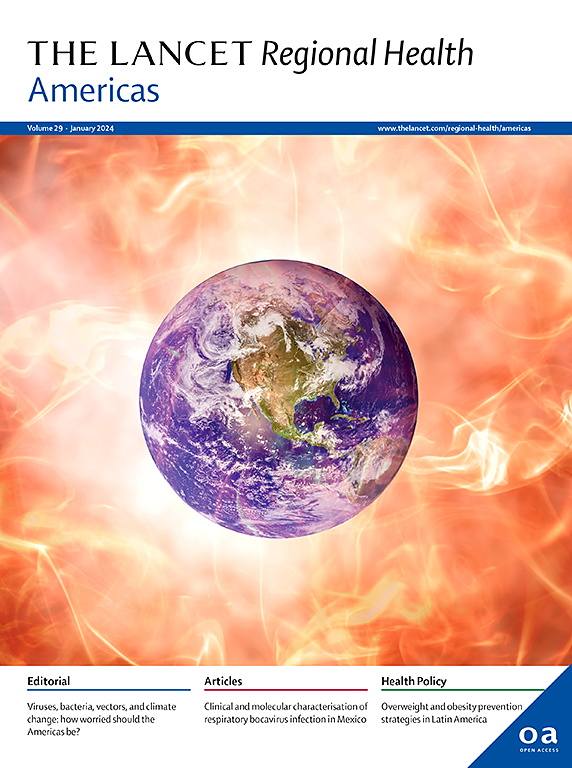巴西亚马逊地区雅诺玛米土著人失明和视力障碍的患病率:CASAI-Y的横断面观察研究
IF 7
Q1 HEALTH CARE SCIENCES & SERVICES
引用次数: 0
摘要
美洲土著居民,特别是在偏远地区,面临着严重的卫生不平等。亚诺马米人是生活在亚马逊地区的一个高度流动的土著民族,他们的眼部健康数据很少。本研究旨在估计雅诺马米人视力障碍和失明的患病率及其原因,为孤立人群的公共卫生规划做出贡献。方法于2024年6月至8月在巴西博阿维斯塔的亚诺马米土著卫生之家(CASAI-Y)进行了一项横断面观察研究。通过综合眼科检查对158例年龄≥5岁的雅诺玛米人进行评估,包括表现视力(PVA)、最佳矫正视力(BCVA)、自动验光、动态验光、眼压、眼底摄影和裂隙灯检查。根据ICD-11标准对视力障碍进行分类。发现PVA导致的中度或重度视力损害和失明的发生率为15.8%,BCVA组下降至8.2%。白内障和未矫正的屈光不正是视力丧失的主要原因。视力障碍在男性和40岁以上的人群中更为常见。经屈光矫正后,视力有统计学上的显著改善(p <;0.001)。文化和后勤障碍被确定为进入的主要限制。雅诺马米人可预防性视力损害的高负担强调了对可获得和适应文化的眼科保健服务的需求。矫正镜片和白内障手术可以大大提高生活质量。应优先考虑有针对性的战略,包括流动筛查、土著保健代理人和远程眼科,以预防可避免的失明。FundingNo资金。本文章由计算机程序翻译,如有差异,请以英文原文为准。
Prevalence of blindness and visual impairment among yanomami Indigenous people in the Brazilian Amazon region: a cross-sectional observational study at CASAI-Y
Background
Indigenous populations in the Americas experience significant health inequities, especially in remote areas. Among the Yanomami, a highly mobile Indigenous people living in the Amazon, ocular health data are scarce. This study aimed to estimate the prevalence and causes of visual impairment and blindness among the Yanomami, contributing to public health planning for isolated populations.
Methods
A cross-sectional observational study was conducted between June and August 2024 at the Yanomami Indigenous Health House (CASAI-Y), in Boa Vista, Brazil. A total of 158 self-identified Yanomami individuals aged ≥5 years were evaluated through comprehensive eye exams including presenting visual acuity (PVA), best-corrected visual acuity (BCVA), autorefractometry, dynamic refractometry, tonometry, fundus photography, and slit-lamp examination. Visual impairment was classified according to the ICD-11 criteria.
Findings
The prevalence of moderate or worse visual impairment and blindness based on PVA was 15.8%, decreasing to 8.2% with BCVA. Cataract and uncorrected refractive error were the leading causes of visual loss. Visual impairment was more frequent among men and individuals aged >40 years. Statistically significant improvements in visual acuity were achieved with refractive correction (p < 0.001). Cultural and logistical barriers were identified as major limitations to access.
Interpretation
The high burden of preventable visual impairment in the Yanomami population underscores the need for accessible and culturally adapted eye care services. Corrective lenses and cataract surgery could substantially improve quality of life. Targeted strategies including mobile screening, Indigenous health agents and teleophthalmology should be prioritized to prevent avoidable blindness.
Funding
No funding.
求助全文
通过发布文献求助,成功后即可免费获取论文全文。
去求助
来源期刊

Lancet Regional Health-Americas
Multiple-
CiteScore
8.00
自引率
0.00%
发文量
0
期刊介绍:
The Lancet Regional Health – Americas, an open-access journal, contributes to The Lancet's global initiative by focusing on health-care quality and access in the Americas. It aims to advance clinical practice and health policy in the region, promoting better health outcomes. The journal publishes high-quality original research advocating change or shedding light on clinical practice and health policy. It welcomes submissions on various regional health topics, including infectious diseases, non-communicable diseases, child and adolescent health, maternal and reproductive health, emergency care, health policy, and health equity.
 求助内容:
求助内容: 应助结果提醒方式:
应助结果提醒方式:


